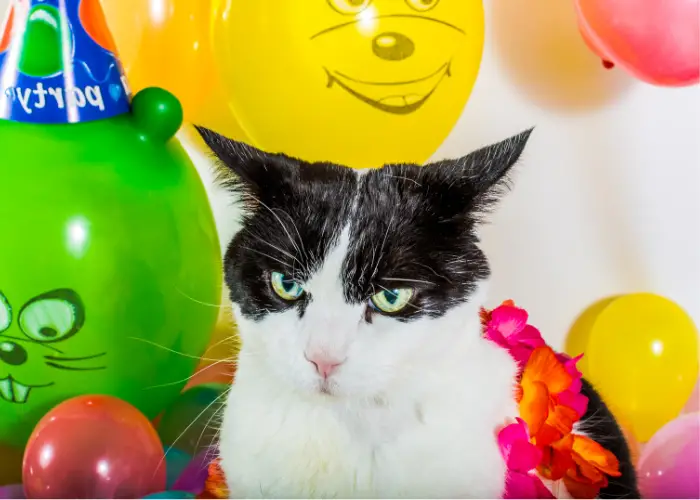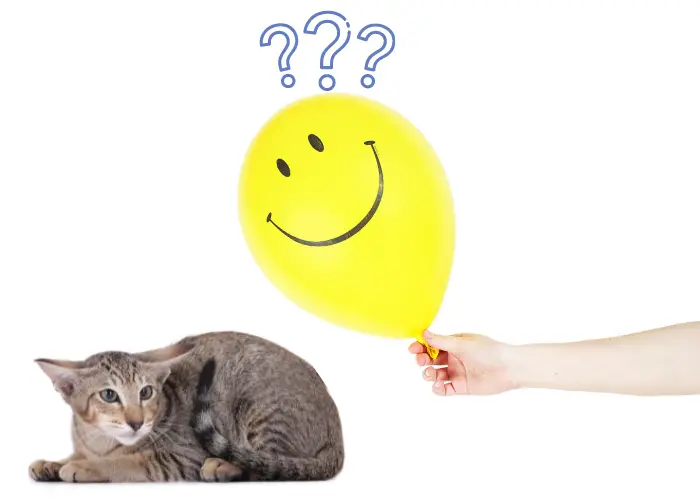Cats with keen senses and cautious dispositions often exhibit an intriguing fear of balloons.
This aversion stems from various sensory and instinctual triggers that provoke a stress response in these agile animals. Below are five refined insights into why balloons might unsettle our feline companions.
1. The Startle of Sudden Sounds
The sharp sound of a balloon popping can be intensely startling for cats.
Their ears are tuned to pick up high-frequency sounds, making the explosive noise of a bursting balloon akin to a sudden, loud threat, like fireworks.
This auditory shock can trigger a cat’s acute stress response, urging them to escape the source of the disturbance.
2. Erratic Movements
The way balloons drift and dart through the air, often without clear direction, can be disconcerting for cats.
These animals rely on predictability in their environment to feel secure. The balloon’s capricious movements, compounded by the odd sounds they emit when jostled, can activate a cat’s instinct to flee from what it perceives as a potential danger.
3. Alien Appearance
To a cat, a balloon might be visually unusual and potentially menacing. Floating or bobbing objects, especially those that invade their familiar spaces, can be interpreted as threats from above, reminiscent of predatory birds.
The balloon’s peculiar form and behavior in space can thus spark a defensive or fearful reaction.
4. Innate Wariness
Cats are inherently cautious and often apprehensive about new or out-of-place environmental elements.
This natural wariness means that balloons, with their unconventional presence and behavior, can easily be categorized as potential threats, heightening a cat’s anxiety and fearfulness towards them.
5. Unexpected Sensations
The static charge balloons often carry can deliver surprising jolts to a cat’s sensitive fur and skin, adding another layer of discomfort.
This, coupled with their general sensitivity to sudden tactile, auditory, and visual stimuli, can make the experience of encountering a balloon particularly distressing for a cat.
In understanding these facets of feline perception and instinct, cat owners can better navigate their pets’ interactions with balloons, ensuring a more serene and stress-free environment for their cherished companions.
Case Studies and Anecdotes

Real-life stories from pet owners provide valuable insights into how cats react to balloons.
kemkomacar95 shared their story about their cat’s fear of balloons. They discovered their cat reacted negatively to a balloon, hiding inside a carrier and hissing and growling when approached with the balloon.
Another user with the alias sapphomelon mentioned that their cat doesn’t mind balloons and often tries to play with the strings attached.
This indicates that cats can react differently to balloons, much like people have varying responses to different stimuli.
Source: Reddit
By combining professional advice with real-world experiences, we can develop a more nuanced understanding of how to help our cats navigate their fears.
It’s about respecting their instincts while gently guiding them towards feeling secure in their environment.
Safety First: Balloons and Cats

While balloons can add a festive touch to any celebration, it’s crucial to prioritize our feline friends’ safety and comfort.
Understanding the potential dangers and adopting safety measures can prevent accidents and ensure a happy coexistence.
Potential Dangers of Balloons to Cats
Balloons, particularly when they burst, can pose several risks to cats:
- Choking Hazard: Pieces of burst balloons can be accidentally ingested by cats, leading to choking or intestinal blockages.
- Latex Allergies: Some cats might be allergic to latex, which can cause skin irritations or more severe allergic reactions.
- String Threat: The strings attached to balloons can be dangerous if ingested, leading to possible entanglement or internal blockages, a condition known as linear foreign body.
Comprehensive Safety Guidelines
To mitigate these risks, consider the following guidelines:
- Supervised Interaction: Always supervise your cat when balloons are present. Remove the balloons immediately if you notice any signs of stress or aggression.
- Balloon Quality: Opt for high-quality balloons that are less likely to pop unexpectedly and cause fright or harm.
- No Strings Attached: Avoid leaving balloons with strings attached unattended. If using strings, ensure they are kept well out of reach of your cat.
- Alternative Decorations: Consider cat-friendly decorations that don’t pose a risk, such as paper decorations, which can be just as festive without the dangers associated with balloons.
- Immediate Cleanup: Promptly dispose of any balloon pieces or deflated balloons to prevent your cat from chewing on or swallowing them.
By adhering to these safety guidelines, you can enjoy the festivities without compromising your cat’s well-being.
Helping Your Cat Cope

Adjusting your cat to the presence of balloons involves patience, understanding, and a gradual approach.
Here are some strategies to help your cat become more comfortable around balloons, ensuring a stress-free environment.
Behavioral Modification Techniques
Controlled exposure and positive reinforcement can be utilized to desensitize your cat to balloons effectively and help them become more comfortable.
Here’s a comprehensive approach blending both the original and revised techniques:
- Start with a Deflated Balloon at a Distance: Begin the desensitization process by introducing a deflated balloon from a safe distance, ensuring it doesn’t trigger any fear or anxiety in your cat. Allow your cat to observe the balloon in this harmless state, establishing an initial comfort level.
- Create Positive Associations: Pair the presence of the balloon, even from afar, with positive experiences such as treats, favorite toys, or playtime. This counterconditioning helps replace any negative feelings towards the balloon with positive ones.
- Gradual Introduction and Distance Management: Slowly decrease the distance between your cat and the deflated balloon over several sessions, carefully observing your cat’s reactions. Ensure each step respects your cat’s comfort level and retreat threshold.
- Introduce Inflation Gradually: Once your cat seems at ease with the deflated balloon, gradually introduce an inflated balloon. This step should be cautiously approached, ensuring the process remains gradual and stress-free, to avoid any sudden fear response.
- Supervised Interaction: Allow your cat to explore and interact with the balloon under close supervision. Ensure they have the freedom to retreat if they start to feel uncomfortable, maintaining a safe environment for exploration.
- Monitor and Adjust Based on Cat’s Comfort: Throughout the process, keenly observe your cat for any signs of discomfort, such as dilated pupils, tense posture, or avoidance behavior. If any distress is noticed, increase the distance between the balloon and your cat or reduce the intensity of the exposure, always working below the fear threshold.
Combining these steps creates a structured yet flexible approach to desensitization and counterconditioning.
This method not only focuses on the physical aspects of introducing the balloon but also emphasizes the psychological comfort of your cat, ensuring a positive and gradual adaptation process.
Alternatives to Balloons in a Cat Household
If balloons prove too stressful for your cat, or you prefer to avoid the risks altogether, there are plenty of cat-safe alternatives to keep the festive spirit alive:
- Paper Decorations: Colorful paper streamers or garlands can add a festive touch without the risk of popping or choking hazards.
- LED Lights: Soft, battery-operated LED lights can create a celebratory atmosphere without the movement or noise of balloons.
- Interactive Cat Toys: Celebrate with new cat toys that encourage play and interaction, providing entertainment for your cat and guests.
Understanding your cat’s perspective and taking a thoughtful approach to introductions and alternatives can create an enjoyable and safe celebratory environment for your feline friend.
Building a Community: Your Stories

Creating a community around shared experiences can be incredibly enriching and educational.
We invite you, our readers, to participate in this journey, sharing your stories, tips, and questions about cats and balloons.
Your insights can help others navigate similar challenges, fostering a supportive and informed network of cat enthusiasts.
User-generated content and Experiences
We’d love to hear from you:
- Success Stories: Have you successfully desensitized your cat to balloons? What strategies worked for you?
- Challenges Faced: Were there any particular hurdles you encountered? How did you overcome them?
- Creative Alternatives: Have you found innovative alternatives to balloons that your cat loves?
Share your ideas and inspire others!
By contributing to this community, you’re sharing valuable knowledge and helping build a comprehensive resource that can benefit cat owners worldwide.
Conclusion

Navigating the curious world of cats and balloons can be amusing and challenging.
We’ve explored the science behind cats’ fear of balloons, from their sensitive hearing to their instinctual responses to unpredictable movements.
Understanding these reactions is crucial for creating a safe and comfortable environment for our feline companions.
Real-life anecdotes underscore how cats can respond to balloons, illustrating the broad spectrum of feline behavior.
Also, the contrasting responses highlight the unique personalities and individual thresholds for stimuli among cats, reminding us of the complexity and diversity in their reactions to similar situations.
Safety guidelines remind us of balloons’ potential risks and the importance of prioritizing our pets’ well-being in all situations.
For those seeking alternatives or facing significant challenges, we’ve discussed various strategies and creative solutions to ensure celebrations remain joyful without causing distress to our cats.
By sharing stories and tips within our community, we continue to learn and grow together, enhancing our understanding and care for our beloved pets.
Call to Action
We encourage you to share your experiences, tips, and questions in the comments below.
Your insights can help others in our community and contribute to a deeper understanding of cat behavior.
A professional animal behaviorist can provide tailored advice if you face severe challenges.
Understanding and empathy are key to a harmonious relationship with our pets.
Let’s continue to support each other in creating happy, safe homes for our feline friends.
REFERENCES:
Patterson, C. (2019, January 22). A Cat’s Five Senses. Texas A&M College of Veterinary Medicine & Biomedical Sciences. https://vetmed.tamu.edu/news/pet-talk/a-cats-five-senses/


